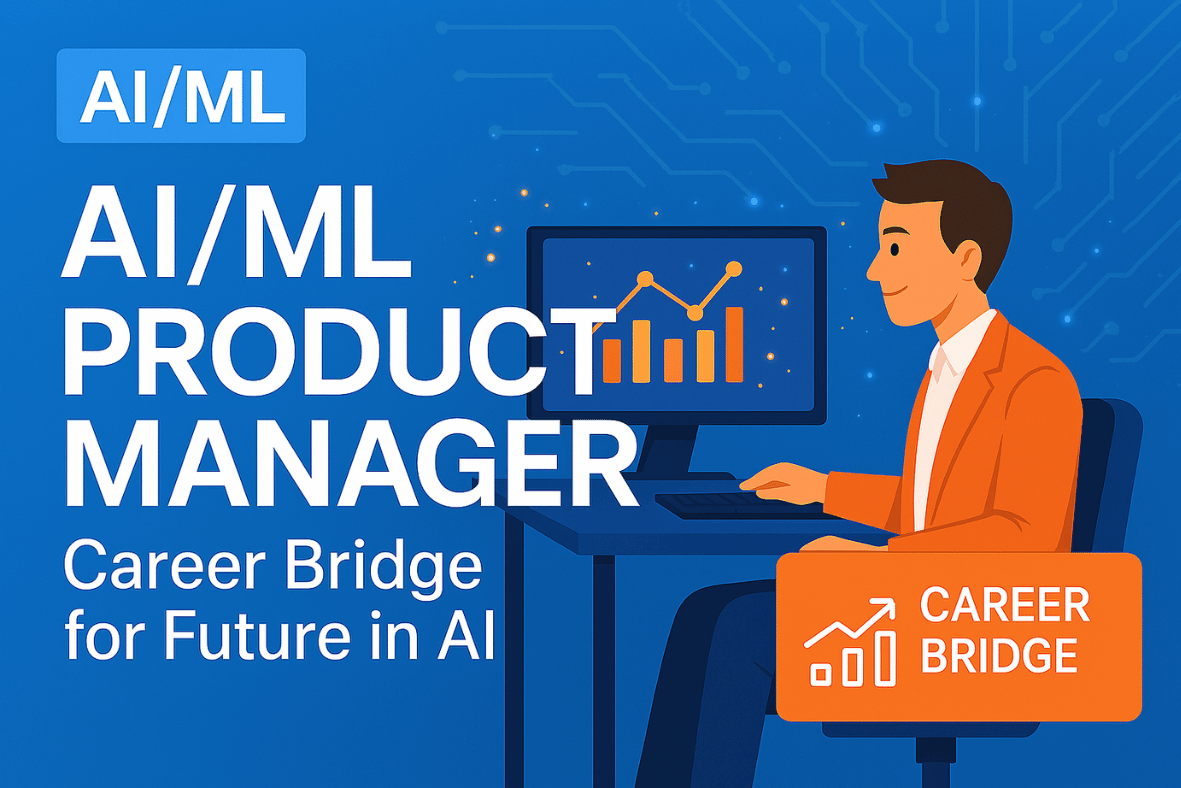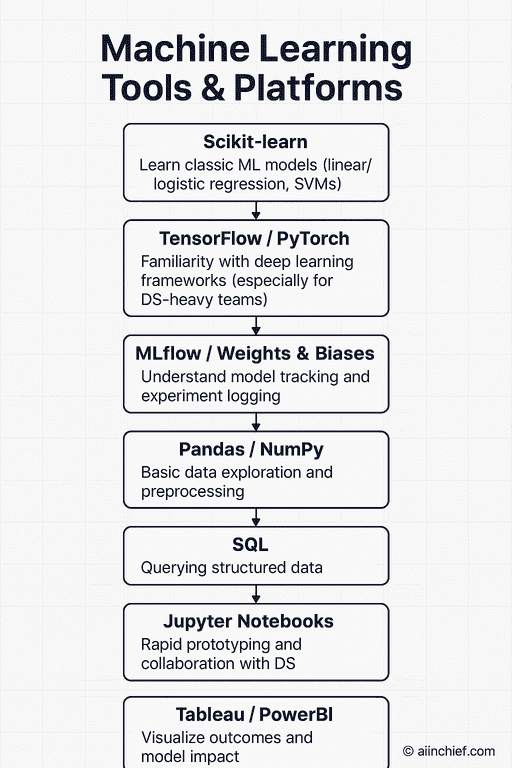ML Product Manager's Career Bridge for Future in AI
The role of the Machine Learning Product Manager (ML PM) is quickly becoming mission-critical. But How do you break into this specialized role? what should you focus on to prepare? This article serves as your career bridge - a practical guide to help you step confidently into the ML product world.

🧭A Successful ML Product Manager
A Machine Learning Product Manager combines product leadership with data and algorithmic intuition. They're responsible for identifying valuable AI opportunities, translating business needs into ML problem statements, and guiding cross-functional teams through model development, evaluation, and deployment.
They don’t need to code every model- but they must speak the language of data scientists, understand model limitations, and define what "good" looks like when it comes to model performance.
🎓 What You’ll Learn
By the end of this article, you’ll have clarity on:
- What makes an ML Product Manager successful
- Core responsibilities and required capabilities
- Tools and frameworks to master
- How to upgrade your resume with the right keywords
- Quick strategies to prepare for interviews - even with limited time
- How to get hands-on experience through an internship
🌍 Why This Role Matters in the AI Future
Every product in the future will be AI-augmented or AI-native.
Whether it’s a recommendation engine, fraud detection system, predictive analytics dashboard, or conversational assistant - ML PMs ensure these features solve the right problems with the right data.
The ML PM is the glue between business, data science, and engineering, enabling AI to become usable, trustworthy, and valuable to end users.
⭐ Key Success Factors for ML Product Managers
- AI Fluency Without Jargon
- Explain concepts like supervised learning, overfitting, or ROC-AUC in business terms.
- Strong Prioritization & Scoping
- Know what data to collect, which models to explore, and how to prioritize iterative launches.
- Model Evaluation Awareness
- Understand the difference between model performance and product performance.
- Collaboration with DS & MLEs
- Translate business requirements into data features and model use cases.
- Responsible AI Mindset
- Embed fairness, bias detection, and explainability from day one.
🎯 Key Responsibilities of an ML Product Manager
| Responsibility | Description |
|---|---|
| Problem Framing | Translate user needs into ML problem types (classification, regression, etc.) |
| Data Strategy | Identify the data needed, and collaborate on pipelines with data teams |
| Model Lifecycle Management | Oversee training, evaluation, deployment, and monitoring of ML models |
| Metrics Definition | Define success metrics like precision, recall, F1-score, ROC, etc. |
| Experimentation & A/B Testing | Set up experiments to validate model impact |
| User & Business Alignment | Ensure model outputs enhance user experiences and business goals |
| Risk Management | Identify potential biases, edge cases, or failure modes |
| Communication | Regularly report performance, limitations, and roadmap to stakeholders |
🧠 Capabilities You Need to Succeed
| Capability | Description |
|---|---|
| ML Fundamentals | Understand algorithms, data splits, training vs inference |
| Evaluation & Metrics | Precision, recall, F1, RMSE, calibration curves |
| Data Strategy | Know what clean, labeled, and useful data looks like |
| Business Impact Framing | Connect ML outcomes to KPIs and revenue impact |
| Product Thinking | Drive iterative model launches and feedback loops |
| Collaboration | Communicate clearly with DS, MLEs, stakeholders, and legal |
| Responsible AI | Apply fairness, bias detection, privacy compliance |
🛠 Top Tools to Learn & Crack the Interview

| Tool / Platform | Purpose |
|---|---|
| Scikit-learn | Learn classic ML models (linear/logistic regression, SVMs) |
| TensorFlow / PyTorch | Familiarity with deep learning frameworks (especially for DS-heavy teams) |
| MLflow / Weights & Biases | Understand model tracking and experiment logging |
| Pandas / NumPy | Basic data exploration and preprocessing |
| SQL | Querying structured data |
| Jupyter Notebooks | Rapid prototyping and collaboration with DS |
| Tableau / PowerBI | Visualize outcomes and model impact |
| Docker / FastAPI | Understand ML deployment architecture basics |
| Git / Jira / Notion | Workflow and documentation collaboration tools |
🔑 Top Keywords to Include in Your Resume
Use these resume-enhancing keywords and phrases to stand out:
- “ML product lifecycle ownership”
- “Model evaluation using precision/recall/F1”
- “Business-aligned machine learning metrics”
- “Experimentation-driven product design”
- “Supervised/unsupervised model deployment”
- “Data pipeline collaboration”
- “Responsible and explainable AI practices”
- “ML-driven personalization/recommendation systems”
- “Stakeholder communication on model performance”
🙌 Don’t Have the Experience? Do an Internship With Us!
🎯 Want to break into the ML PM space but lack real-world experience?
📢 Join our Internship Program for ML Product Managers.
You’ll:
- Collaborate with real data science teams
- Scope and design an ML feature end-to-end
- Build your portfolio and case studies
- Learn model lifecycle management on real projects
✅ Apply today and make the leap into AI Product Management!
⏱️ If You Only Had 1 Hour to Prepare...
Here’s how to cram effectively for an ML PM interview:
- Skim through: One ML product case study on Medium or GitHub
- Practice explaining: A model’s impact using a metric (e.g., "Why did precision drop after retraining?")
- Write out: A 3-bullet model success metric plan for a use case (e.g., email categorization)
- Rehearse: How you’d explain overfitting to a non-technical stakeholder
📅 Prepare for It: 1 Day, 1 Week, 4 Weeks
✅ 1 Day Plan
- Read top ML PM job descriptions
- Watch 2 crash course videos on ML basics and metrics
- Outline one ML product idea with success metrics
🧠 1 Week Plan
- Build a basic ML classifier in scikit-learn (e.g., sentiment analysis)
- Write a 1-pager product brief for an ML feature
- Study metrics like precision, recall, ROC-AUC, etc.
🚀 4 Week Mastery
- Complete one ML case study project from Kaggle or GitHub
- Collaborate with a DS to frame a use case
- Publish a case study or product story on Medium or LinkedIn
- Join mock interviews or attend AI PM meetups
💡 Final Thoughts
The ML Product Manager is the bridge between cutting-edge machine learning and real-world impact. If you're passionate about data, business outcomes, and delivering AI-driven value- this is your moment.
📣 Start preparing now.
🚀 Build your portfolio.
💼 Step confidently into the future of AI product leadership.

